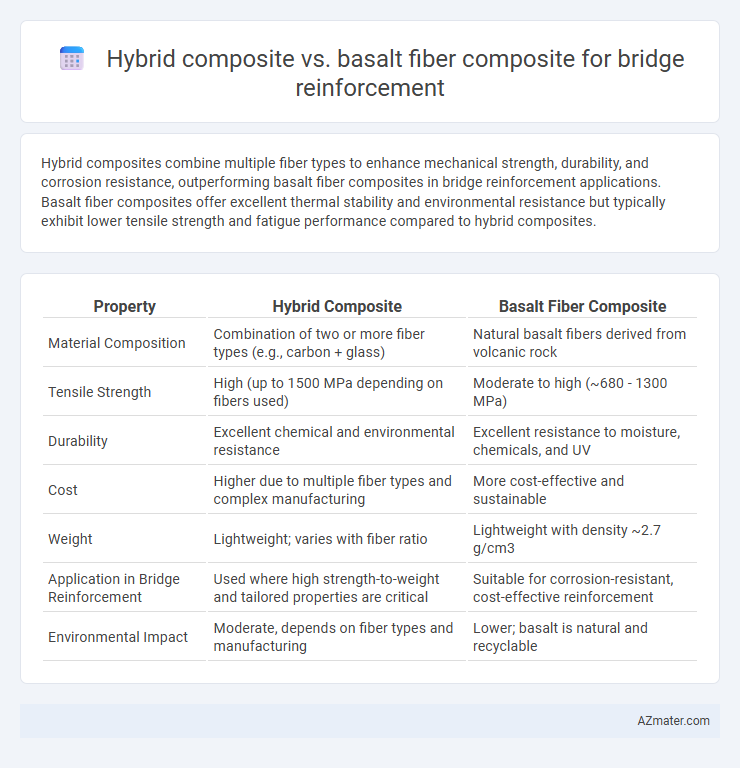Hybrid composites combine multiple fiber types to enhance mechanical strength, durability, and corrosion resistance, outperforming basalt fiber composites in bridge reinforcement applications. Basalt fiber composites offer excellent thermal stability and environmental resistance but typically exhibit lower tensile strength and fatigue performance compared to hybrid composites.
Table of Comparison
| Property | Hybrid Composite | Basalt Fiber Composite |
|---|---|---|
| Material Composition | Combination of two or more fiber types (e.g., carbon + glass) | Natural basalt fibers derived from volcanic rock |
| Tensile Strength | High (up to 1500 MPa depending on fibers used) | Moderate to high (~680 - 1300 MPa) |
| Durability | Excellent chemical and environmental resistance | Excellent resistance to moisture, chemicals, and UV |
| Cost | Higher due to multiple fiber types and complex manufacturing | More cost-effective and sustainable |
| Weight | Lightweight; varies with fiber ratio | Lightweight with density ~2.7 g/cm3 |
| Application in Bridge Reinforcement | Used where high strength-to-weight and tailored properties are critical | Suitable for corrosion-resistant, cost-effective reinforcement |
| Environmental Impact | Moderate, depends on fiber types and manufacturing | Lower; basalt is natural and recyclable |
Introduction to Bridge Reinforcement Materials
Hybrid composites combine the superior tensile strength of carbon or glass fibers with the durability and cost-effectiveness of basalt fibers, enhancing load-bearing capacity and corrosion resistance in bridge reinforcement. Basalt fiber composites, derived from natural volcanic rock, offer exceptional thermal stability, high tensile strength, and resistance to chemical attacks, making them a sustainable alternative to traditional materials like steel or fiberglass. Both materials contribute significantly to extending bridge lifespan and reducing maintenance costs by improving structural performance under dynamic stresses and environmental exposure.
Overview of Hybrid Composite Materials
Hybrid composite materials combine basalt fibers with other reinforcements such as carbon or glass fibers to enhance mechanical properties, corrosion resistance, and durability for bridge reinforcement applications. These composites exhibit improved tensile strength, stiffness, and fatigue resistance compared to pure basalt fiber composites, making them suitable for high-performance structural demands. The synergistic effect of hybridization optimizes the balance between cost, weight, and long-term performance in bridge strengthening and rehabilitation projects.
Understanding Basalt Fiber Composites
Basalt fiber composites offer superior durability and corrosion resistance compared to hybrid composites, making them ideal for bridge reinforcement exposed to harsh environmental conditions. The high tensile strength and thermal stability of basalt fibers enhance the structural integrity and lifespan of reinforced concrete elements. Utilizing basalt fiber composites in bridge applications results in reduced maintenance costs and improved performance under cyclic loading and chemical exposure.
Mechanical Properties: Hybrid vs Basalt Fiber
Hybrid composites combine basalt fibers with other reinforcing fibers, resulting in enhanced mechanical properties such as improved tensile strength, stiffness, and impact resistance compared to basalt fiber composites alone. Basalt fiber composites exhibit excellent corrosion resistance and high tensile strength but may have lower stiffness and impact resistance than hybrid blends tailored for specific load-bearing applications. The optimized synergy in hybrid composites maximizes load distribution and durability, making them superior for bridge reinforcement where mechanical performance and longevity are critical.
Durability and Environmental Resistance
Hybrid composite materials combining basalt fibers with other reinforcing fibers exhibit superior durability and environmental resistance compared to pure basalt fiber composites in bridge reinforcement applications. The synergy in hybrid composites enhances resistance to moisture, UV radiation, and chemical degradation, significantly extending the service life of reinforced structures in harsh environments. Basalt fiber composites alone offer excellent thermal stability and corrosion resistance, but hybridization optimizes mechanical performance and long-term durability under cyclic loading and aggressive conditions.
Installation and Constructability Factors
Hybrid composites offer enhanced installation flexibility and reduced curing times compared to basalt fiber composites, enabling faster bridge reinforcement projects. Basalt fiber composites provide superior chemical resistance and lightweight properties but may require specialized handling and longer curing periods, impacting constructability. Selecting the optimal composite depends on project timelines, environmental exposure, and ease of onsite application to ensure efficient reinforcement.
Cost Analysis: Hybrid vs Basalt Fiber
Hybrid composites combining basalt fibers with carbon or glass fibers generally offer a cost advantage over pure basalt fiber composites due to optimized material usage and enhanced mechanical performance. Basalt fiber composites, while providing superior corrosion resistance and durability, often incur higher raw material and processing costs. Evaluating lifecycle expenses, hybrid composites may present lower total costs through balanced strength-to-cost ratios and reduced maintenance requirements in bridge reinforcement applications.
Performance in Real-world Bridge Applications
Hybrid composites combining basalt fibers with other materials offer enhanced tensile strength, impact resistance, and durability compared to pure basalt fiber composites in bridge reinforcement. Real-world bridge applications demonstrate hybrid composites provide superior fatigue resistance and improved crack control under dynamic loading conditions, leading to extended service life and reduced maintenance costs. Data from recent case studies highlight that hybrid composites exhibit better environmental resilience against moisture and temperature fluctuations, crucial for long-term structural integrity.
Case Studies and Comparative Insights
Case studies on bridge reinforcement reveal that hybrid composite materials, which combine basalt fibers with other fibers like carbon or glass, show enhanced tensile strength and durability compared to pure basalt fiber composites. Comparative insights highlight that basalt fiber composites offer superior corrosion resistance and environmental sustainability, while hybrid composites provide greater load-bearing capacity and crack mitigation under dynamic stresses. Implementations in bridges demonstrate that hybrid composites can extend service life and reduce maintenance costs more effectively than basalt fiber composites alone.
Conclusion: Choosing the Right Composite for Bridge Reinforcement
Hybrid composites combining basalt fiber and other materials offer enhanced mechanical properties and durability benefits compared to pure basalt fiber composites, making them suitable for demanding bridge reinforcement applications. Basalt fiber composites exhibit excellent corrosion resistance and high tensile strength, providing a cost-effective, eco-friendly alternative for standard reinforcement needs. Selecting the right composite depends on specific bridge performance requirements, environmental exposure, budget constraints, and long-term maintenance considerations.

Infographic: Hybrid composite vs Basalt fiber composite for Bridge reinforcement
 azmater.com
azmater.com